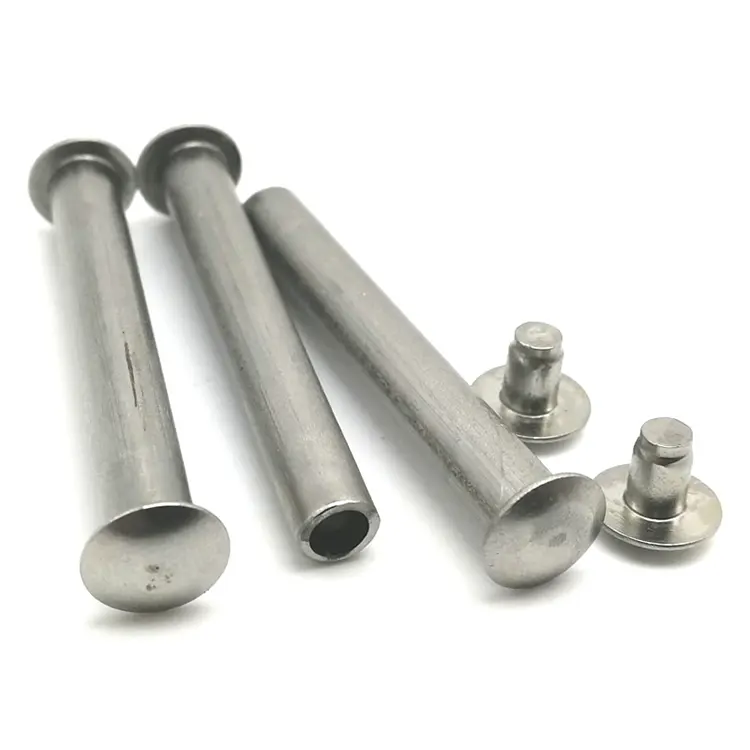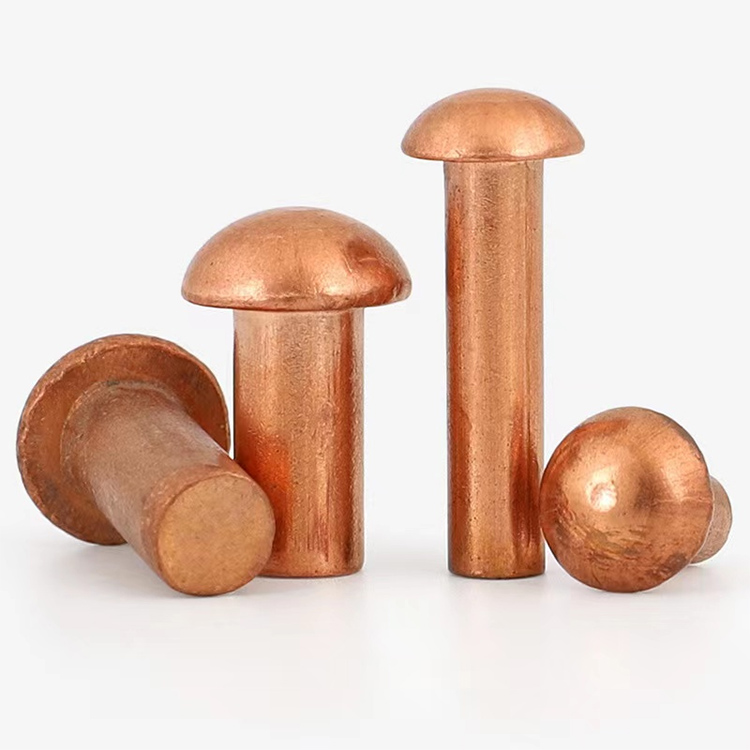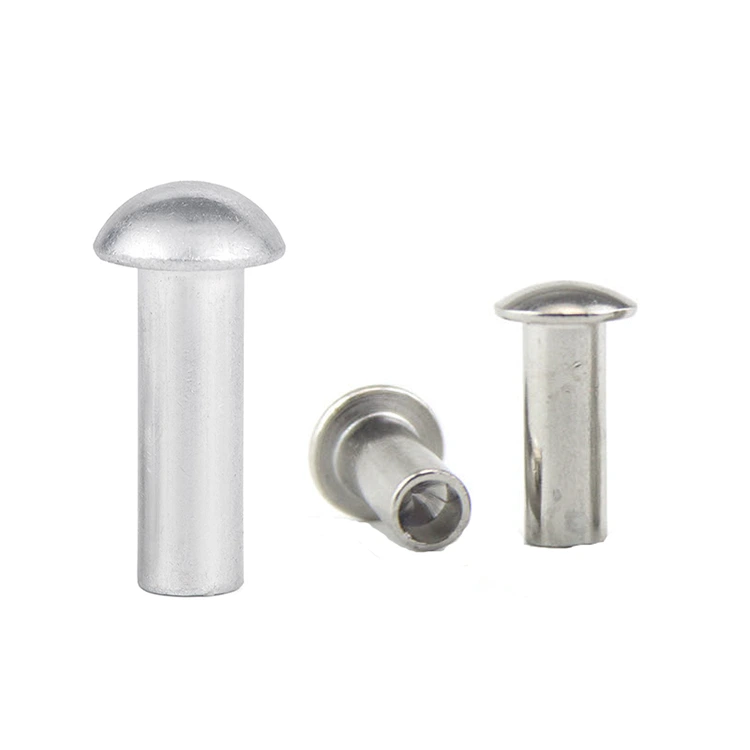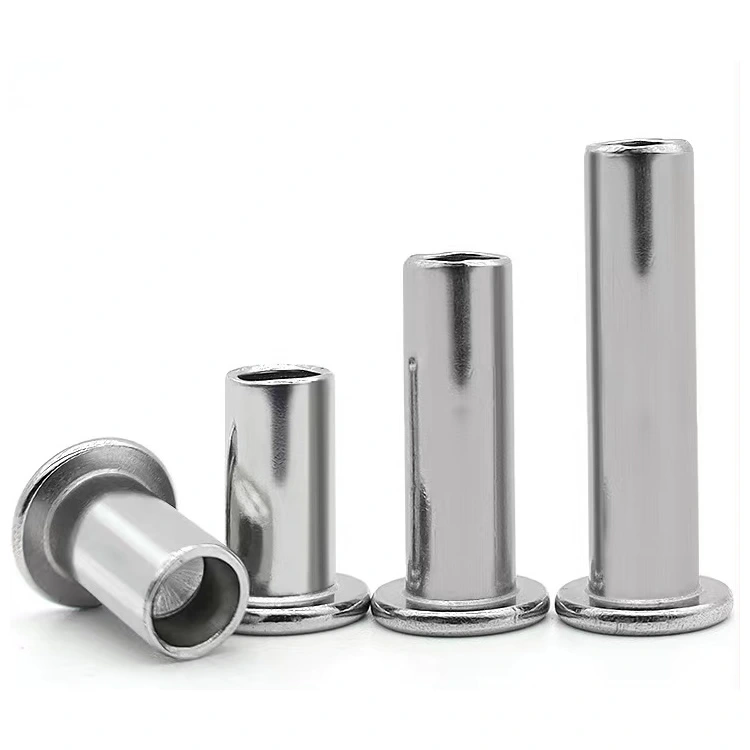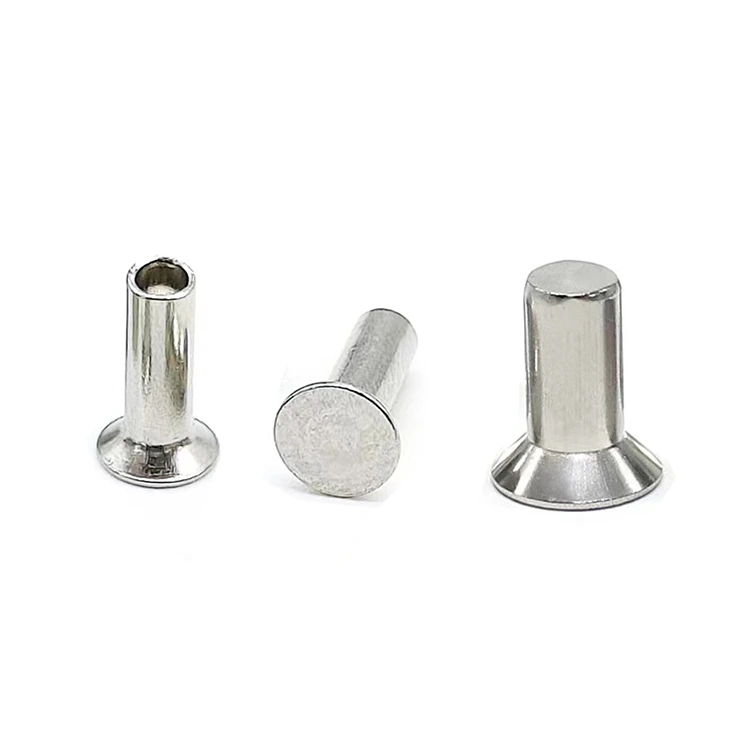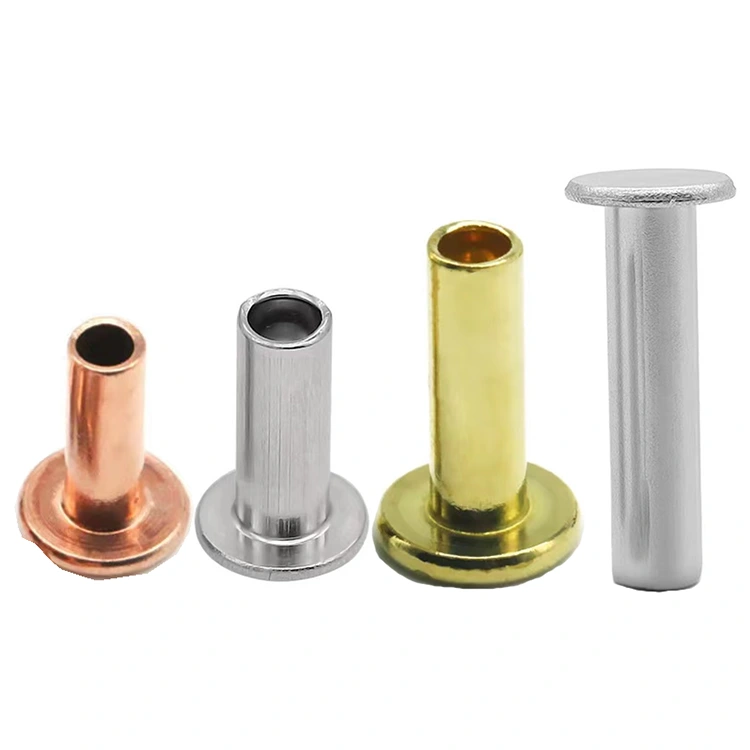Rebites semi -tubulares
You can purchase Semi Tubular Rivets from Notin with confidence, as we are a proficient producer of high-quality Semi Tubular Rivets. We promise to provide you with the best after-sale service and prompt delivery.
Semi-tubular rivets are a common mechanical fastener widely used in industrial manufacturing, electronic equipment, automotive parts, and other fields. Their structure lies somewhere between solid and hollow rivets, with a solid head and a hollow tail, combining the advantages of both. The following analyzes the characteristics of semi-tubular rivets and their differences from other rivets from various perspectives.
What are semi-tubular rivets?
Semi-tubular rivets typically have a solid cylindrical or round head and a hollow tubular tail. During installation, pressure is applied to the tail using a riveting tool, causing it to curl outward and form a secure locking structure. This process requires no pre-tapping or welding, making it suitable for quick assembly. In contrast, solid rivets require greater pressure to deform, while fully hollow rivets (such as blind rivets) rely on the mandrel to break to secure, requiring higher material strength.
What head shapes are available for semi-tubular rivets?
Semi-tubular rivet head shapes generally include flat heads (flat heads, suitable for applications requiring smooth surfaces), domed heads (semi-circular heads, aesthetically pleasing and practical, commonly used in construction, automotive, and other fields), countersunk heads (heads embedded within the material, suitable for applications requiring concealed connections), and large flat heads. Different head shapes can be selected based on your needs.

Materials and Strength of Semi-tubular Rivets
Common materials for semi-tubular rivets include aluminum, copper, steel, and stainless steel. Aluminum rivets are lightweight and corrosion-resistant, making them suitable for electronic devices; steel rivets are stronger and are often used in load-bearing structures. Compared to solid rivets, semi-tubular rivets are lighter but have slightly lower shear strength. Compared to full tubular rivets, their curled tails provide a larger contact area, resulting in a more stable connection.
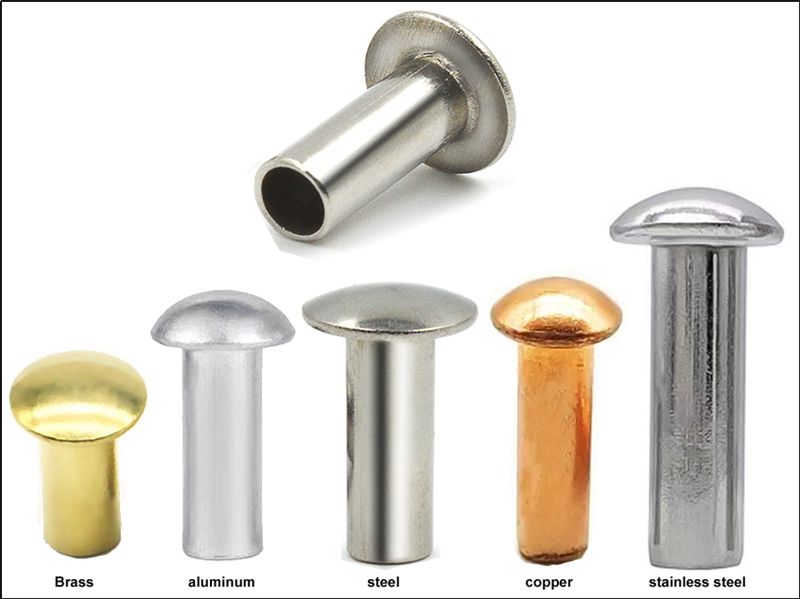
What are semi tubular rivets primarily used for?
Typical uses for semi-tubular rivets include:
-Automotive manufacturing: securing interior panels or wiring harness brackets to prevent loosening under vibration.
-Home appliance assembly: connecting metal casings to prevent deformation caused by welding. -Hardware Tools: Assemble movable parts such as pliers and scissors, ensuring a balance between flexibility and durability.
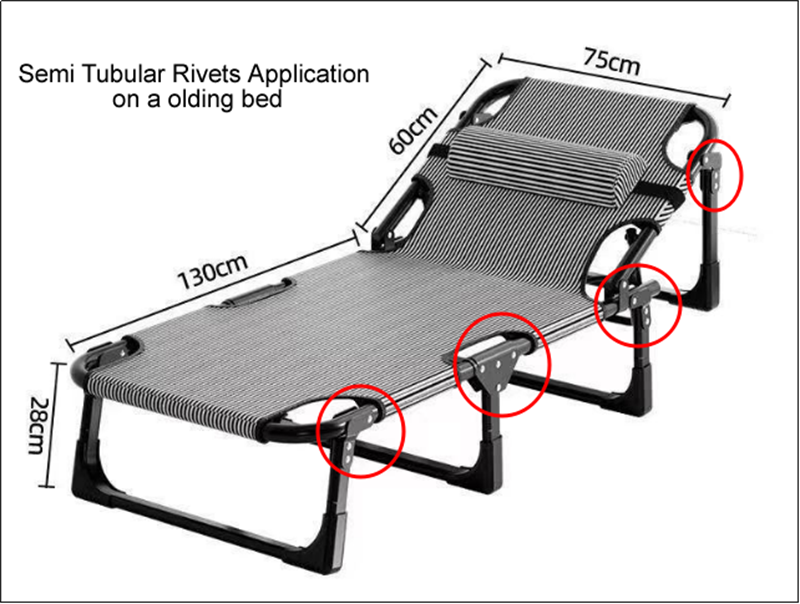
Semi Tubular Rivet Installation Cost
Semi-tubular rivets can be installed with a standard rivet gun or punch, and can be operated by a single person. They are faster than welding or bolting. For example, the cost per aluminum rivet is approximately 0.05-0.3 RMB, which is lower than stainless steel bolts but higher than ordinary blind rivets. Their advantage is that they require no maintenance over long-term use, eliminating the need for anti-loosening washers or regular tightening.
Limitations of Semi Tubular Rivets
The main disadvantages of semi-tubular rivets are:
-Difficulty in Disassembly: Once a joint is established, it requires multiple drilling and destruction methods to remove it.
-Thickness Limitation: The total thickness of the joined materials is generally no more than twice the length of the hollow portion of the rivet.
-Surface Treatment Requirements: For outdoor use, choose galvanized or stainless steel to prevent rust.
Comparison with Other Fasteners
-Bolts and Nuts: They are removable and have a higher load-bearing capacity, but require access from both sides and are more expensive. - Welding: Excellent connection strength, but thermal deformation may affect precision, and it's not suitable for materials like aluminum and copper.
- Adhesives: No mechanical stress, but poor high-temperature resistance and aging resistance.
In summary, semi-tubular rivets strike a balance between lightweight, easy installation, and cost, making them particularly suitable for specialized connections with medium loads. When selecting a rivet, consider material compatibility, environmental conditions, and load-bearing requirements to ensure a suitable match.
- View as
Rebites semi-ocos de latão
Na Nuote Metals, nos concentramos na fabricação de rebites semi-ocos de latão. Nossos rebites usam principalmente latão H65 – uma mistura de cobre-zinco que oferece excelente condutividade elétrica e térmica, além de sólida resistência à corrosão. Este material é suficientemente duro e flexível para funcionar bem com processos de encabeçamento a frio e rebitagem. Além disso, o latão tem aquela cor dourada natural, portanto, se você estiver usando-o para fins decorativos, muitas vezes não precisará de nenhum revestimento extra.
consulte Mais informaçãoEnviar consultaRebites meio ocos de cabeça panela
Você já se perguntou como nossos rebites meio ocos de cabeça panela são feitos? Aqui está um rápido passo a passo:
Primeiro, escolhemos o fio de metal certo e o cortamos no comprimento exato necessário. Em seguida, segue para a máquina de encabeçamento a frio, que punciona e molda o fio no formato básico do rebite – é aí que a cabeça panela e a haste oca realmente tomam forma. O próximo passo é o tratamento térmico; ajustamos o tempo e a temperatura com base no material para garantir que cada rebite tenha a resistência e a resistência corretas. Depois disso, muitas vezes adicionamos um acabamento protetor – como galvanização ou passivação – para ajudá-los a combater a ferrugem e durar mais tempo. E nunca ignoramos a verificação final: cada lote é examinado para confirmar se o tamanho, o acabamento e o desempenho estão de acordo com o padrão.
Estamos sempre felizes em mostrar o local aos clientes – se você estiver na área, avise-nos e marcaremos um tour!
Rebites meio ocos com cabeça de cogumelo
Os rebites meio ocos com cabeça de cogumelo recebem esse nome devido à sua cabeça distinta em forma de cúpula, que se parece um pouco com uma tampa de cogumelo, combinada com uma haste parcialmente oca. Este design permite que o rebite se modele durante a instalação, criando uma fixação forte – perfeito para usos onde você precisa de boa aparência e desempenho sólido. Quando ajustada, a extremidade oca se alarga e segura firmemente, enquanto a cabeça e a seção superior da haste permanecem sólidas para suporte extra.
consulte Mais informaçãoEnviar consultaRebites meio tubulares de ferro
Os rebites semi-tubulares de ferro são conectores mecânicos com cauda oca. Eles funcionam apertando a parte oca e flangeando-a para fora para criar uma fixação de encaixe permanente. As principais aplicações estão concentradas em indústrias leves, como vestuário, calçados e malas. O uso de material de arame macio evita rachaduras durante as juntas de rebites e oferece vantagens de custo. Nuote Metals é um fabricante profissional de rebites semi-tubulares de ferro. Nossos rebites são de alta qualidade e cada um passa por uma inspeção minuciosa para garantir a satisfação do cliente.
consulte Mais informaçãoEnviar consultaRebites semi-ocos de cabeça escareada
Por que escolher rebites semi-ocos de cabeça escareada em vez de outros métodos de conexão? Isto se deve principalmente às suas vantagens exclusivas. Após a instalação, o cabeçote fica nivelado com a superfície, evitando possíveis interferências ou riscos de segurança causados por saliências. O design semi-oco torna o processo de rebitagem relativamente simples, não necessitando de equipamentos complexos; geralmente pode ser concluído manualmente ou com ferramentas pneumáticas. Este tipo de rebite é adequado para materiais de diversas espessuras, podendo ser adaptado a diversas situações ajustando a força de rebitagem.
consulte Mais informaçãoEnviar consultaRebites meio ocos de cabeça chata
A rebitagem é um método comum de fixação de dois ou mais componentes na fabricação industrial e na manutenção diária. Os rebites meio ocos de cabeça plana são um tipo de rebite que oferecem design exclusivo e vantagens de aplicação. Nuote Metals é um fabricante profissional de rebites meio ocos de cabeça chata. Estamos localizados em Dongguan, China, e temos recursos abundantes de tratamento de superfície e transporte conveniente, o que reduz o custo de produção de rebites.
consulte Mais informaçãoEnviar consulta
